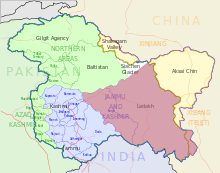User:Manishanjali/sandbox
LADAKH[edit]
CONTENTS
Geography
History
Culture
Flora and Fauna
Tourism

GEOGRAPHY[edit]
Ladakh _the land of high passes is a region in INDIAN state of Jammu and Kashmir that curently extends from Kunlun mountain range to the main great HIMALAYAS to the south,inhabited by the people of Indo-Aryan and Tibet descent.It is the highest altitude plateau region in India incorpoating parts of the Himalayan and Karakoram mountain ranges and the upper Indus River valley. The Suru River forms the western and northern boundary of the Zanskar range.The Indus River is the backbone of Ladakh;all the major places historically and currently such as Leh,Shey,Basgo and Tingmosgang are situated close to the river.[edit]
Ladakh is situated near to the Himalayas .The enormous mass of Himalayas creates a rain shadow,denying entry to the moisture-laden clouds of the Indian monsoon.Ladakh is thus ,a high alttude desert. The main source of water is the winter snowfall on the mountains.The regions on the north flank of the Himalayas -Dras, the Suru valley and Zanskar experiece heavy snowfall.Summers are short, although long enough to grow crops. The proportion of oxygen is less than in many other places at a comparable altitude because of lack of vegetation.There is little moisture to temper the effects of rarefied air.[edit]
HISTORY[edit]

Ladakh was claimed Cas part of Tibet by Phuntsok Wangyal, a Tibetian communist leader . In 1947, partition left Ladakh a part of the Indian state of Jammu and Kashmir, to be administrated from Srinagar. In 1948, Pakistan raiders invaded Ladakh and occupied Kargil and Zanskar, reaching within 30 km of Leh.[edit]
Ladakh can hardly be considerd a seperate politician entity before the establishment of the kingdom about 950 CE , after the collapse of the early Tibetian Empire and the border regions became independent kingdoms under independent rules , most of whom came from branches of the Tibetian royal family.[edit]
CULTURE[edit]

Ladakhis are known for their cheerful disposition and most of their festivals fall in winters, which serve as an excuse for social and convivial gatherings. In summers, archery competitions and native version of polo are quite common and especially among the Buddhists, these competitions are often a local ball where folk songs and dances add to the jovial atmosphere and 'Chang', the local barley beer is amply used. The rich collection of oral literature of the region is full of occasion-special songs and poems and includes the localized versions of the Tibetan epic, 'Kesar Saga'.[edit]
The Buddhist influence on Ladakh culture started as early as the 7th century . And now, this faith has gained dominance in this entire region. All over Ladakh, you will find ancient Buddhist rock engravings, even in the few areas dominated by Muslims.The religion of the state also follows tibetians as well as buddist influences. Most of the chants are in Sanskrit or tibetian. Lifestyle of leh ladakh: Besides the culture, region also influences the lifestyle in Leh Ladakh.[edit]
FLORA AND FAUNA[edit]

Flora and Fauna of Ladakh are in keeping with the mountainous nature of the region variety. There are a number of species found here which is quite remarkable considering the height of the region and the rugged nature of its terrain. While some of the plant and animal species show behavioural characteristics which have helped them adapt to the high altitude, such as hibernation, or seasonal migration from higher to lower elevations in winter, there are also certain behavioural traits which enable them to adjust to the mountainous clime. These include enlargement of the nasal cavity, the development of thick fur etc.[edit]
The flora and fauna of Ladakh closely resembles with that of Tibet.The flora of Ladakh comprises about 880 species. Ladakh is rich repository of medicinal and aromatic plants and other important plants which are closely associated with daily life of local inhabitants of the region.[edit]

Many species of finches, robins, redstarts (like the black redstart) and the hoopoe are common in summer. The brown-headed gull is seen in summer on the river Indus, and on some lakes of the Changthang. Resident water-birds include the brahminy duck also known as the ruddy sheldrake, and the bar-headed goose (Ladakhi: ngangpa). The black-necked crane (trhung-trhung) is a rare species found scattered in the Tibetan plateau, and is also found nesting in summer in parts of Ladakh. Other birds include the raven, red-billed chough (chungka), Tibetan snowcock and chukar (a partridge, srakpa). The lammergeier and the golden eagle are common raptors here. Marshes of Ladakh is a good breeding ground for many migratory birds.[edit]
TOURISM[edit]

